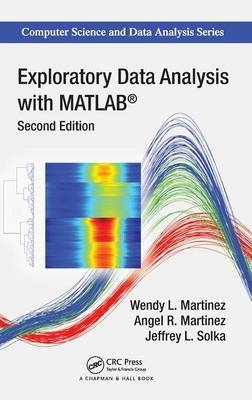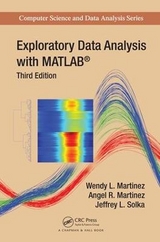
Exploratory Data Analysis with MATLAB, Second Edition
Crc Press Inc (Verlag)
9781439812204 (ISBN)
- Titel erscheint in neuer Auflage
- Artikel merken
New to the Second Edition
Discussions of nonnegative matrix factorization, linear discriminant analysis, curvilinear component analysis, independent component analysis, and smoothing splines
An expanded set of methods for estimating the intrinsic dimensionality of a data set
Several clustering methods, including probabilistic latent semantic analysis and spectral-based clustering
Additional visualization methods, such as a rangefinder boxplot, scatterplots with marginal histograms, biplots, and a new method called Andrews’ images
Instructions on a free MATLAB GUI toolbox for EDA
Like its predecessor, this edition continues to focus on using EDA methods, rather than theoretical aspects. The MATLAB codes for the examples, EDA toolboxes, data sets, and color versions of all figures are available for download at http://pi-sigma.info
Wendy L. Martinez has been in government service for over 20 years, working with leading researchers from academia, industry, and government labs. During this time, she has conducted and published research in text data mining, probability density estimation, signal processing, scientific visualization, and statistical pattern recognition. A fellow of the American Statistical Association, she earned an M.S. in aerospace engineering from George Washington University and a Ph.D. in computational sciences and informatics from George Mason University. Angel R. Martinez teaches undergraduate and graduate courses in statistics and mathematics at Strayer University. Before retiring from government service, he worked for the U.S. Navy as an operations research analyst and a computer scientist. He earned an M.S. in systems engineering from the Virginia Polytechnic Institute and State University and a Ph.D. in computational sciences and informatics from George Mason University. Since 1984, Jeffrey L. Solka has been working in statistical pattern recognition for the Department of the Navy. He has published over 120 journal, conference, and technical papers; has won numerous awards; and holds 4 patents. He earned an M.S. in mathematics from James Madison University, an M.S. in physics from Virginia Polytechnic Institute and State University, and a Ph.D. in computational sciences and informatics from George Mason University.
INTRODUCTION TO EXPLORATORY DATA ANALYSIS
Introduction to Exploratory Data Analysis
What Is Exploratory Data Analysis
Overview of the Text
A Few Words about Notation
Data Sets Used in the Book
Transforming Data
EDA AS PATTERN DISCOVERY
Dimensionality Reduction - Linear Methods
Introduction
Principal Component Analysis (PCA)
Singular Value Decomposition (SVD)
Nonnegative Matrix Factorization
Factor Analysis
Fisher’s Linear Discriminant
Intrinsic Dimensionality
Dimensionality Reduction - Nonlinear Methods
Multidimensional Scaling (MDS)
Manifold Learning
Artificial Neural Network Approaches
Data Tours
Grand Tour
Interpolation Tours
Projection Pursuit
Projection Pursuit Indexes
Independent Component Analysis
Finding Clusters
Introduction
Hierarchical Methods
Optimization Methods—k-Means
Spectral Clustering
Document Clustering
Evaluating the Clusters
Model-Based Clustering
Overview of Model-Based Clustering
Finite Mixtures
Expectation-Maximization Algorithm
Hierarchical Agglomerative Model-Based Clustering
Model-Based Clustering
MBC for Density Estimation and Discriminant Analysis
Generating Random Variables from a Mixture Model
Smoothing Scatterplots
Introduction
Loess
Robust Loess
Residuals and Diagnostics with Loess
Smoothing Splines
Choosing the Smoothing Parameter
Bivariate Distribution Smooths
Curve Fitting Toolbox
GRAPHICAL METHODS FOR EDA
Visualizing Clusters
Dendrogram
Treemaps
Rectangle Plots
ReClus Plots
Data Image
Distribution Shapes
Histograms
Boxplots
Quantile Plots
Bagplots
Rangefinder Boxplot
Multivariate Visualization
Glyph Plots
Scatterplots
Dynamic Graphics
Coplots
Dot Charts
Plotting Points as Curves
Data Tours Revisited
Biplots
Appendix A: Proximity Measures
Appendix B: Software Resources for EDA
Appendix C: Description of Data Sets
Appendix D: Introduction to MATLAB
Appendix E: MATLAB Functions
References
Index
Summary, Further Reading, and Exercises appear at the end of each chapter.
| Erscheint lt. Verlag | 7.1.2011 |
|---|---|
| Reihe/Serie | Chapman & Hall/CRC Computer Science & Data Analysis |
| Zusatzinfo | There will be an 8-page color insert containing 15 figures.; 11 Tables, black and white; 15 Illustrations, color; 133 Illustrations, black and white |
| Verlagsort | Bosa Roca |
| Sprache | englisch |
| Maße | 156 x 234 mm |
| Gewicht | 934 g |
| Themenwelt | Mathematik / Informatik ► Mathematik ► Computerprogramme / Computeralgebra |
| ISBN-13 | 9781439812204 / 9781439812204 |
| Zustand | Neuware |
| Informationen gemäß Produktsicherheitsverordnung (GPSR) | |
| Haben Sie eine Frage zum Produkt? |
aus dem Bereich



